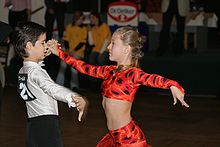Cha-cha-cha (dance)

Junior dance competition in the Czech Republic
|
|
| Genre | Ballroom dance |
|---|---|
| Time signature | 4/4 |
| Year | 1953 |
| Origin | Cuba |
The cha-cha-chá, or simply cha-cha in the U.S., is a dance of Cuban origin. It is danced to the music of the same name introduced by Cuban composer and violinist Enrique Jorrin in the early 1950s. This rhythm was developed from the danzón-mambo. The name of the dance is an onomatopoeia derived from the shuffling sound of the dancers' feet.
In the early 1950s, Enrique Jorrín worked as a violinist and composer with the charanga group Orquesta América. The group performed at dance halls in Havana where they played danzón, danzonete, and danzon-mambo for dance-orientated crowds. Jorrín noticed that many of the dancers at these gigs had difficulty with the syncopated rhythms of the danzón-mambo. To make his music more appealing to dancers, Jorrín began composing songs where the melody was marked strongly on the first downbeat and the rhythm was less syncopated. When Orquesta América performed these new compositions at the Silver Star Club in Havana, it was noticed that the dancers had improvised a triple step in their footwork producing the sound "cha-cha-cha". Thus, the new style came to be known as "cha-cha-chá" and became associated with a dance where dancers perform a triple step.
The basic footwork pattern of cha-cha-chá (two, three, cha-cha-cha) is also found in several Afro-Cuban dances from the Santería religion. For example, one of the steps used in the dance for the orisha Ogun uses an identical footwork pattern. These Afro-Cuban dances predate the development of cha-cha-chá and were known by many Cubans in the 1950s, especially those of African origin. Thus, some have speculated that the footwork of the cha-cha-chá was inspired by these Afro-Cuban dances.
In 1953 Orquesta América released two of Jorrin’s new compositions, "La Engañadora" and "Silver Star", on the Cuban record label Panart. These were the first cha-cha-chá compositions ever recorded. They immediately became hits in Havana, and other Cuban charanga orchestras quickly imitated this new style. Soon, there was a cha-cha-chá craze in Havana’s dance halls, popularizing both the music and the associated dance. This craze soon spread to Mexico City, and by 1955 the music and dance of the cha-cha-chá had become popular in Latin America, the United States, and Western Europe, following in the footsteps of the mambo, which had been a worldwide craze a few years earlier.
...
Wikipedia
